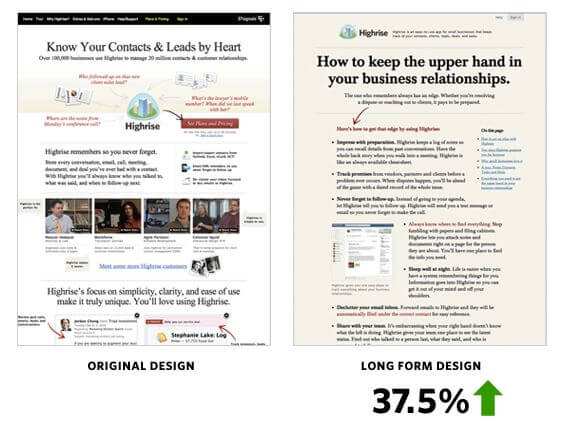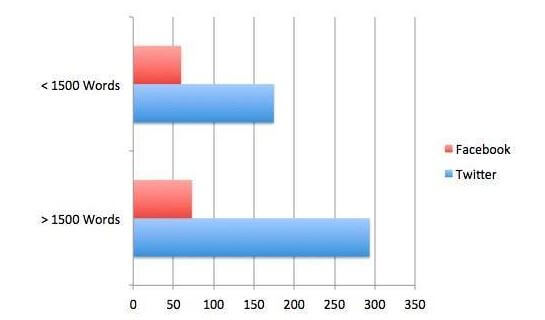Are you struggling to rank some keywords that should be easy? Are you having trouble attracting an audience to your site, even though you think you’re offering some great information? If so, then maybe you should consider adding more long-form content.
To put it succinctly, long-form content can make you look like more of an expert in your field, increase the likelihood of engagement and sharing,
improve your search engine results page (SERP) rank, and increase your audience; because of your content, you will be viewed as an “authority” on the subject. All of that works to your benefit and translates to better brand awareness.
What Is Long-Form Content?
Long-form content is variously defined throughout the Interweb. However, the consensus is pretty clear on one point: If you’re just looking to get past a 500-word mark so that the search engines take notice of your content, then you’re not publishing long-form content.
My personal rule of thumb is that anything less than 1,200 words isn’t long-form content. I’d advise to aim for over 1,500 words, since 1,200 is (in my opinion) the minimum. That way, you’ll have a competitive advantage with the extra cushion.
But why not go all in? Set a goal of 2,000 words for your long-form content. I haven’t published a post less than 1,000 words for some time. I am generally going for 1,500 to 7,000 words now.
A Recently Recognized Benefit
When readers started moving to the internet, media analysts thought long-form journalism was in trouble. Attention spans were going to shrivel. Readers wanted short, they wanted snappy, they wanted 140 characters and not much more (though a listicle on the side couldn’t hurt). Who would want to scroll through an 8,000-word article on an iPhone screen?
Many are now realizing that the inevitable “death” of long-form content was greatly exaggerated, and digital marketers are discovering that long-form content is extremely valuable for both users and search engines alike.
The SEO Benefit
The exact algorithm that Google uses to determine which pages should go straight to the top of the SERPs for a given query is, of course a mystery (at least, it is to everyone outside of a certain corporate headquarters in Mountain View, California).
However, curious engineers can tinker and experiment — as much as the search engines will allow them — to gain some insight about what ranks well.
Long-Form Content Ranks Very Well
Back in 2012, serpIQ conducted
a study involving more than 20,000 keywords. The results showed that the average content length of each of the top 10 results was more than 2,000 words. The average number of words for the content in the #1 spot was 2,416. For the #10 spot, the average number of words was 2,032.
That evidence is fairly conclusive. If you want your articles to rank well, consider using long-form content.
Google Says So
The theory that long-form content benefits search engine optimization (SEO) is corroborated by a hint that’s been dropped on the
Google Webmasters Central Blog. Pandu Nayak, technical staff member at Google and creator of the Panda algorithm update, posted the following:
Users often turn to Google to answer a quick question, but research suggests that up to 10% of users’ daily information needs involve learning about a broad topic. That’s why today we’re introducing new search results to help users find in-depth articles.
That’s a very suggestive hint that long-form content tends to rank well. Nayak also advised webmasters to use
schema.org markup,
authorship markup (the rich snippet for which has since disappeared from search results) and provide information about the company’s logo when producing long-form content as a way to further increase the likelihood of a good ranking.
Long-Form Content Garners More Backlinks, On Average
Not only do the search engines seem to intrinsically love long content, but you’ll find an additional SEO benefit from writing a couple of thousand words: more backlinks. Of course, those additional backlinks will help you rank with the SERPs, as well.
A study conducted by Moz shows a direct correlation between the length of the content and the number of backlinks pointing to it. It’s further evidence that long-form content is great for SEO.
Still, Only Death And Taxes Are Guaranteed
Before you trot back to your content management system with this newfound knowledge, thinking with certainty that if you speed-type 2,078 words about how to lose 50 pounds in six weeks you’re going to be in the #1 spot on Google’s search results, keep in mind that you’re not guaranteed to rank well just because you use long-form content.
The fact of the matter is that the search engine algorithms look at a lot of factors. I could, of course, go on about all the factors, but that is not really what this post is about.
Still, all else being equal, quality long-form content should increase the likelihood that you’ll rank for relevant terms. And that’s what it’s really all about, isn’t it?
Ranking your content for a particular keyword is a probability game. You increase your odds with long-form content. That’s the only promise here.
Long-Form Content Can Increase Conversion Rates
If you’re operating a blog that issues some type of call-to-action, whether you’re looking to build your email list or sell something, then you’ll find that long-form content can play a role in your conversion rate.
A Classic Study
There’s a classic case study that demonstrates the effectiveness of long-form content in generating more conversions. Highrise Marketing wanted to increase signups with its website. The company contracted out the conversion process to a couple of professionals who engaged in some split testing. They found that the home page with long-form content saw
an increase in conversion rate of more than 37 percent.
Similarly, Crazy Egg saw its conversion rate
increase by more than 30 percent with the use of long-form content. In that case, the longer-form content was about 20 times the length of its shorter counterpart.
According to the Crazy Egg blog: “The media would have us believe that people no longer have any capacity to concentrate. In reality, you cannot have a page that’s too long — only one that’s too boring. In the case of Crazy Egg’s home page, visitors wanted their many questions answered and that’s what we delivered.”
Crazy Egg also produced
a guide to creating long-form content that increases your conversion rate.
There’s Nothing New Under The Sun
It’s not just in the digital era that long-form content works in marketing. You might be old enough to remember receiving direct mail solicitations that were pages long. Marketing professionals found that wordy pitches yielded better results.
For example, famous advertiser David Ogilvy
once said: “All my experience says that for a great many products, long copy sells more than short… [A]dvertisements with long copy convey the impression that you have something important to say, whether people read the copy or not.”
In that assessment, Ogilvy is backed up by Dr. Charles Edwards, former dean of the Graduate School of Retailing at New York University. He’s
quoted as saying: “The more facts you tell, the more you sell. An advertisement’s chance for success invariably increases as the number of pertinent merchandise facts included in the advertisement increases.”
In his book,
Tested Advertising Methods, John Caples
writes: “Advertisers who can trace the direct sales results from their ads use long copy because it pulls better than short copy… Brief, reminder-style copy consisting of a few words or a slogan does not pull inquiries as well as long copy packed with facts and reader benefits about your product or service.”
That “longer is better” principle seems to hold true in online venues, as well as old-school advertising. If you’re having trouble with a site that’s giving you a stubbornly low conversion rate, employ some long-form content on the site, and see if that makes a difference.
Social Media Hearts Long-Form Content
One of the best ways to draw in a large audience and increase engagement, as well as conversions, is to create content that’s shareable on social media. Long-form content has historically outperformed its shorter content little brother in that metric, as well.
Neil Patel conducted an experiment with some of his own content on Quick Sprout, a blog that offers tips for digital marketers. Patel found that out of 327 blog posts he wrote, the posts under 1,500 words received an average of 174 tweets and 59 Facebook likes. The content that was over 1,500 words, on the other hand, received an average of 293 tweets and 75 likes.
As many of you know, I run a popular blog on our agency’s site known as Ignite Visibility University. After analyzing the posts, I was able to determine that when looking at our top 20 posts, 16 of them were over 1,000 words, one of them was over 800 and the remaining three were on very niche technical topics that almost no one had written on.
NewsWhip also found that long-form content is the most shareable. The company noticed that one of the most widely shared articles in
its study was a transcribed speech by author Neil Gaiman about the importance of reading. That article contained a whopping 3,535 words and was shared more than 220,000 times.
Tips On Long-Form Content
When it comes time for you to produce long-form content, here are a few tips you might find helpful.
All Content Shouldn’t Be Long-Form Content
Even though long-form content is a great way to establish your site as an authority on a particular subject and to help you rank better, you shouldn’t publish everything as long-form content. Some subjects don’t require lengthy content.
For example, if you’d like to share a viral video on your website that you think will draw in an audience, there’s no reason that you need to post 2,000 words explaining the video. For those types of articles, follow Shakespeare’s maxim and recognize that brevity is the soul of wit.
Avoid The Middle
In fact, it seems you’re better off using content that’s one extreme or the other in terms of length. Either use very short content that can be quickly digested by members of a busy society or use long-form content that’s considered the “go to” source for a specific subject.
According to Kevin Delaney, the editor-in-chief of business news site Quartz, articles that range between 500 and 800 words are
least likely to be successful. As a result, he’s encouraged either short form or long-form content — but nothing in between.
Remember: Quality Over Quantity
Keep in mind that while it may be tempting to sacrifice quality for an excessively verbal article, you should resist the urge to do that. Your readers won’t appreciate a great deal of “fluff” in your articles just to meet a word count. That, to me, is the worst thing to do.
Also, if you try to rush through a long-form piece to save some time, you might end up with an excessive number of typos and grammatical errors. The search engines may notice that and penalize your site accordingly. That was one of the hardest things for me to learn, because I like to create content so quickly. But it is better to be patient.
You Can Make Long-Form Content A Quick Read
If you’re interested in appealing to the ADD and/or busy set with your long-form content, you can do that.
For starters, use subheadings to make your content scannable. You’re reading long-form content right now, and yet you’ll find that it’s easy to digest the important points quickly because of the headings.
Also, consider offering a summary of your article at the very top. This is the “Daily Mail” approach, and it’s a fantastic way to give your readers a chance to get the gist of your article without reading the whole thing. Just click on any article at
The Daily Mail, and you’ll see a bullet-point summary of the piece at the top.
Finally, also consider breaking up the monotony of a long-form article with images. It’s best to use relevant images specific to the subject of the article. However, it’s also great to use memes whenever possible because they add humor to the content and allow people to get a quick sense about the content of a subsection.
Listicles Win
If you’re having trouble producing long-form content because you’re typically a very concise writer, consider producing a listicle. That’s an article that’s also a list (think BuzzFeed), such as “23 Reasons to Love the Caribbean.”
You’ll find that long-form content almost magically appears when you’re writing a listicle, and it’s easy to hit that 2,000-word mark. You’ll also have the benefit of creating content that’s very scannable and friendly to busy people.
Wrapping It Up
If you’re looking for a tactic to get a struggling website off the ground, and you haven’t yet created any long-form content, why not give it a try today? You’ll likely find that you reach a wider audience and establish the site as an authority on a particular subject. That, in turn, is going to build brand awareness online.
But keep in mind, long-form content still needs distribution, a keyword strategy and a great title — otherwise it won’t get you there.








